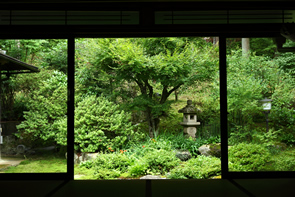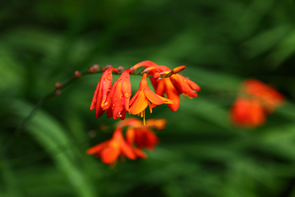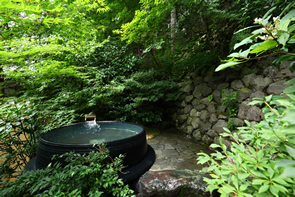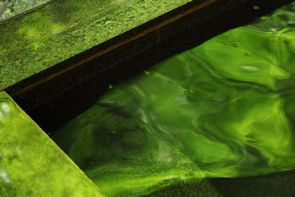
大原の里トップ > A garden at the Kyoto's guest house "Ohara no sato"
It’s already been 20years since I started working with the garden here at “Ohara no Sato”. As I have engaged in the garden maintenance and created the garden of open-air baths, the joy that I have gained from the nature of Ohara and the garden has been priceless. Speaking of the garden maintenance, you might think that the same jobs would be repeated every year, but the pleasant encounter of new nature inhabiting this garden including the rich nature benefiting from the mountains in Ohara and the ever-changing seasons is a real thrill to work with. Although the attraction of this garden can’t be expressed enough in words, I’d like to talk a little about the garden here at “Ohara no Sato” as an expression of my gratitude towards many people who have cherished it.


The main garden facing a parlor and drawing room was created about 40 years ago, at the same time as this guest house was being built and it’s been taken good care of along with the operation of “Ohara no Sato” since then. This garden has a large mountain cherry blossom tree approximately over 150 years old and it blooms beautifully every year.
A valley in the west of Ohara is a picturesque mountain town where Jakkoin Temple and old houses quietly stand, and this garden is created along with a clean stream coming through the trees.
A series of mountains are set in the background of this garden and the spring water emerging from the mountains is brought into the pond by a water pipe. The horseradish grows wild and the forest green tree frogs inhabit by the clear spring water, which reflects the abundance of nature in this area.
The maple tree planted in the garden filters sunlight through its leaves, which provide a dazzling shade, while its foliages turn bright red in autumn. A lush green moss covers the foot of the maple tree, wildflowers such as aster, dogtooth violet, golden-rayed lily and violet appear in places from season to season, and native butterbur and wild plants also add color to the scenery. You could say that this main garden benefits from the rich nature and mountains of Ohara and integrates well with the beautiful landscape.
Next, I’d like to share my expertise from taking care of this garden. The garden care includes pruning to cut off any overgrown branches to shape, weeding to clear away the undergrowth, and cleaning to remove soil deposited in the pond and stream. There are also some other seasonal maintenance required such as cutting buds on pine trees, clipping flowering trees, raking up fallen leaves and arranging a snow protection over the trees called “Yuki-tsuri” in winter.
When landscaping this garden, the crucial thing is not to overwork it. The more you tidy the trees, the more unnatural they look. However, if you don’t do anything to them, they will become a thick bunch of trees and suffer mal-development due to disease and pest.
It is important to draw the natural characteristics of trees by pruning them in an almost unnoticeable way, while checking the surrounding trees to harmonize with. Imagining the beautiful pine trees at the seaside or maple trees near the river having their branches weathered to shape helps me to achieve a natural appearance. I sometimes break off the branches without using scissors or leave the dead branches on purpose. A sharp cut surface caused by scissors doesn’t exist in a natural world and having split branches or leaving some stubborn branches untouched make it so much more natural. Also, they show me a different face every year as the trees grow out of shape and unexpected seedling trees or wild plants start to bud. It sometimes happens that the precious trees, branches or wild plants die. But you need to judge how you deal with all the changes that occur by communicating with trees in order to create the garden adopting Ohara’s nature. In this way, you can keep the virtually unchangeable scenery and the same atmosphere there whenever you see it, which I believe to be an essential point of an excellent garden.
As I harmonize an Ohara’s mountain village with rich nature with the atmosphere within the garden, the mountains become a part of the garden view which can give it a spatial expansion. In the face of the magnificent natural woods, the sophisticated landscaping and trimming seen in house gardens don’t match with the naturally shaped trees in the background. It also makes the garden space look limited and enclosed by not using the natural scenery around it – despite the fact that there are the lush greens symbolizing the abundance nature of Ohara just right behind the garden. With making the use of the enriched nature in Ohara stretched out behind the garden and carefully working on the garden to bring it in, I’m always greeted with the garden and natures of the mountains.


It was 10years when I created the garden of open-air baths which offer three different tastes by utilizing the characteristic of the site.
The garden which you can see from an indoor bath through a wide frame provides a view of the traditional Japanese bath called “Goemon-buro” in order for you to anticipate the outdoor experience that is to come. At the half open-air bath, the garden skillfully utilizes the bumps and a long stretch of ground to create a three-dimensional view and has the “Goemon-buro” as a centerpiece.
At the open-air bath, you can enjoy the garden with an open-feel impression where you can look through the sky between trees at the skirts of the mountain.
The framed outside view from the indoor bath limits the sight of the garden yet beckons you outside. It leads you to the half open-air bath as you feel the moist air of the garden, and when you look up, the garden of open-air bath spreads before your eyes. The open-air bath in the garden becomes a part of the view when you see it from the other baths. But when you are in the outdoor bath, you will not only appreciate the landscaped garden but also enjoy the ambience of nature in the mountainous town as well as the stars and moon in the night sky. All the views you can see from there are cleverly adapted into this garden.
Although each bath is set in the distance to sense the existence of one another, I arranged the position of the baths not to be disturbed by others and made sure that the guests can spend time relaxing there. Like the main garden, the trees mainly used in the garden include maple trees, camellia, Japanese andromeda, aucuba and bamboo which all wildly grow in Ohara. I tidy the trees in the respectful manner of their original shape without trimming them in any fancy way to make them blend with the nature of Ohara, so that you can enjoy every seasonal aspect of the mountainside village.
In terms of the garden care, I prune the trees focusing on the withered leaves and unwanted branches in order not to overwork and lose its naturalness and ensure that they harmonize with the views of Ohara and a spatial extent is achieved.
The stones used in the garden hold an important place to determine the expression, texture and quality of the garden depending on how you use them. It was lucky that the excellent stones in Kyoto such as Kurama stone and Kibune stone previously used in the old houses in Ohara could be employed to show the quality of the garden. After examining the face of those stones and studying how to use them and which surface is the best for the front, a rock arrangement, stone piling and stone pitching were done. And then, trees and plants were planted beside those stones to create a view. What I especially paid attention to in this garden was the expression of the stone piles. If you pile them up very neatly, its expression would go flat and featureless and lose its naturalness of rustic flavor. Therefore, I tried to draw the characteristic face of the stones by piling the stones to look like they are almost collapsing to take advantage of the unevenness of the stones
You can enjoy different views seasonally such as fresh greenery in spring, clear stream in summer and red leaves in autumn, but in particular, one of the most attractive views in this garden is in winter. There are lots of snow in Ohara, and the way snow falls onto the trees and moss in the garden has a magical and serene atmosphere. The snow covers all over the garden and the sunlight sparkles on the snow covered ground so beautifully.
I will be happy if you enjoy yourself by experiencing the natural surroundings and changing seasons here at the garden of “Ohara no Sato”























